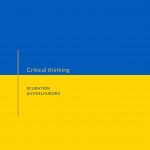This month we are moving away from planned content to highlight how you can use social media to access news.
First: chose trusted news organisations – follow the leading, critical media outlets.
How to know this: Is the news article helpful? Are you getting news with the context and multiple perspectives? Do you feel like you can make your own choice about the events instead of feeling influenced? If in doubt, ask those around you who are very well informed and have complex but balanced views.
What to look out for: Are you getting angry, stressed out and possibly even more biased towards someone? Do you experience intense waves of negative feelings? Feeling low and emotional is normal. Bad news can be hard to process, but you should feel supported by the editors and journalists – you should feel more informed, and that psychologically should make you feel a little less anxious.
Notice your feelings. Notice what the language, titles, pictures evoke in you.
Seek out your local news organisations known for objective reporting and sharing multiple perspectives. They will help you find local actions you can support.
How to know this: check how your local news outlets are funded to identify their interests, preferably look for members owned media (free local newspapers supported by their readers).
What to look out for: local papers with strong ties to leading political parties, businesses or other sources of power that shapes the leading narratives; and local papers with inappropriate advertising or reporting (check how the paper reports on suicides – do they follow the reporting rules?)
Notice your own bias, question it. Do you feel more informed on multiple perspectives?
Research your local, national and global citizen media organisations – news outlets that feature stories of people, reported by individuals on the ground, not always trained as journalists, not always edited.
How to know this: the authors might have it in their bio that they are not journalists, but bloggers, citizen journalists, local voices; check the “about us” section of the website for the organising teams and goals of the platform
What to look out for: online platforms that promote hate, bias, discrimination, target specific groups, undermine trusted news outlets or share content already proved as fake.
Notice if the content you read actually expands your perspective with voices of people involved in events, photos and images posted directly from the affected areas, personal stories.
Follow the leading local, national, global journalists in their professional and personal social media channels. The distinction has been professional and personal channels is crucial. However, their personal channels might give you an indication of the journalist’s integrity.
How to know this: both personal and professional channels are informative, respectful and critical, feature multiple perspectives and explain the context of events.
What to look out for: lack of respect, targeting individuals, highlighting events for the sake of personal promotion over the collective good.
Notice your emotional reaction to the person – do you feel supported? Do you feel you can trust them? If you had an important question or fact, would you share it with them? Would you feel safe around this person?
Follow the leading local, national, global citizen journalists and tap into their networks. This way, you will gain additional perspectives on the current events.
How to know this: citizen journalists might have good, established social media channels but also occasionally contribute to mainstream media (Google them!); check their followers and people they follow – are they connected to trusted sources? Do they converse with trusted professionals?
What to look out for: people who claim to work for mainstream media but actually don’t, people who converse with leading journalists to increase their personal reputation but when Googled don’t have much content to back up their personal reputation and, trolls (people who post for attention, instead of bringing value to the conversation).
Notice if you are learning from them and if you would be OK to share a coffee with them. Notice if those voices are OK with the silence and the backseat when their opinion does not add value to the story.
Find and follow your local, national, global trusted influencers – to receive the news from them. The term “influencer” was highjacked by the social media marketing industry to stand for an online celebrity. However, those celebrity influencers help promote products and ideas, not really a call to action. Actually, some word of mouth marketing reports show that people listen to celebrity influencers but distrust them, so the amount of inspired action can be limited.
How to know this: seek out people who have smaller audiences but are locally recognised and trusted, who post to bring value to their communities.
What to look out for: What you need to remember is that the top celebrities and social media influencers tend to post for financial rewards – that process is often not transparent.
Notice how the influencers you follow interact with each other, especially with less established voices in their community – if they are supportive and respectful, if they promote their peers, that is a good sign.
Find and learn from fact-checking organisations and functions provided by the leading social media platforms. Especially for major events around the world, reach out to the social media channels of organisations known for validating content and educating users on best practices to do so – like for example witness.org
How to know this: notice who is sharing fact-checking practices online – during significant events and in times of peace, look out for organisations supporting prominent journalists and citizen journalists.
What to look out for any form of bias or interest that could motivate an organisation to share lies
Notice your emotional levels of safety – when we feel supported and informed, our anxiety levels go down, and we might feel a little bit more empowered in the light of difficult news as well.
Check before you share. Check the validity of photos your re-share. Read the content of the article before you re-share it. Remember that when you share the content of others, you become the source of the news, too – you need to validate it.
How to know this: if you do not have time to use a fact-checking tool, read the original article and the comments to the original post, too – these days, users pick up fake content pretty fast.
What to look out for: be careful with content that is “too obvious”, quick to support the author’s views (especially if those views are strong and biased).
Notice if you are rushing – maybe pause for a moment before you re-share news.
Critical thinking does not equal having an opinion. Quite the opposite: it takes our view and tests it against our general knowledge of history, politics, geography etc…politics, analyses it, and finally validates it. Critical thinking is so important in reading and sharing news.
As per CiticalThinking.org: “Critical thinking is the intellectually disciplined process of actively and skillfully conceptualizing, applying, analyzing, synthesizing, and/or evaluating information gathered from, or generated by, observation, experience, reflection, reasoning, or communication, as a guide to belief and action. In its exemplary form, it is based on universal intellectual values that transcend subject matter divisions: clarity, accuracy, precision, consistency, relevance, sound evidence, good reasons, depth, breadth, and fairness.”
How to know this: when you read a news article that is balanced, you might feel a sense of complexity, context, multiple points of view or one new aspect to an opinion you are forming about an event.
What to look out for news articles that sit very well with your opinion and validate your biases (we all have those)
Notice if you are feeling 100% certain about something. In the therapy world, we say this: the moment I am certain that I am right, that is exactly when I might be wrong. A little dose of feeling uncertain, uncomfortable and curious might be a good sign of critical thinking. This is how we learn. That is how we grow.
Let us know:
- how do you choose trusted news sources?
- how do you choose trusted local news sources?
- how do you find good citizen media organisations?
- how do you search for trusted journalists on social media?
- how do you find trusted citizen journalists on social media?
- how do you choose your news influencers on social media?
- what fact-checking organisations you are following?
- how do you fact check content posted on social media?
- how do you develop and practise critical thinking?
#StandWithUkraine #Curation #SocialMedia #CriticalThinking #ReflectivePractice

